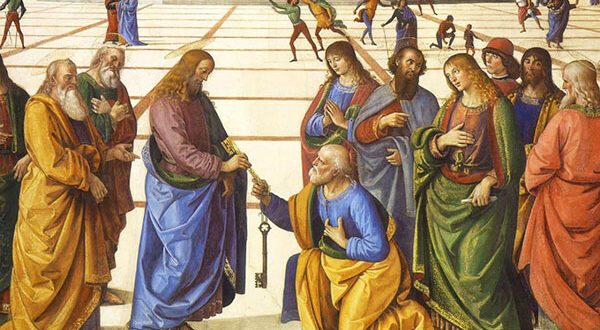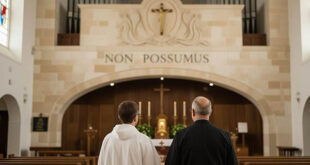Tradition is one of the fundamental pillars on which the Catholic faith is built. While we often hear more about the Bible as a source of revelation, Tradition is equally essential because it is the living transmission of God’s Word throughout the centuries. But what exactly do we mean by Tradition? Where are its teachings found, and how do they impact our lives today? This article aims to answer these questions in a way that is approachable, educational, and profound, addressing the history, theological content, and practical applications of this key concept of the Catholic faith.
What is Tradition in the Catholic Church?
Simply put, Tradition is the living transmission of the Christian faith. From the time of the apostles to the present day, Tradition includes everything the Church has received from Christ and the first disciples and has passed on to future generations.
The word “tradition” comes from the Latin tradere, which means “to hand down” or “to transmit.” And that is, in essence, what Tradition does: it transmits the apostolic faith, the teachings of Jesus, His works, and His example, which are not found solely in Scripture but also in the oral teachings and life of the Church itself.
It’s important not to confuse Sacred Tradition with human traditions or customs, which are cultural or regional practices that may change over time. Sacred Tradition is the transmission of Divine Revelation, meaning what God has revealed for our salvation and what the Church has faithfully preserved throughout the centuries.
Tradition and Scripture: Two Sources of Revelation
To better understand Tradition, it is essential to recognize its relationship with Scripture. In the Catholic Church, God’s Revelation comes to us through two main sources: Sacred Scripture and Sacred Tradition. Both form a single source of Revelation because both stem from the same root: the Word of God.
- Sacred Scripture is the written Word of God, inspired by the Holy Spirit, and contained in the Bible.
- Sacred Tradition, on the other hand, is the living transmission of that Word through the teachings of the apostles and the life of the Church over the centuries.
The Second Vatican Council, in its document Dei Verbum (the Dogmatic Constitution on Divine Revelation), clearly teaches that Tradition and Scripture “must be accepted and honored with equal devotion and reverence” (Dei Verbum, 9). One is not more important than the other; instead, they complement and enrich each other.
While Scripture contains the written revelation, Tradition is the way in which that revelation has been lived, understood, and transmitted in the Church, under the guidance of the Holy Spirit.
What Does Tradition Contain?
Sacred Tradition includes a wide variety of teachings, practices, and beliefs that, although not explicitly detailed in Scripture, have been an integral part of the Christian faith since the early days. Some examples of these teachings and practices are:
- The canon of the Bible: While the Bible is the written Word of God, the list of the books that belong to the Bible is not found within the Bible itself. It was through Tradition that the Church, guided by the Holy Spirit, discerned which books should be included in the canon of Scripture.
- The doctrine of the Holy Trinity: Although the word “Trinity” does not appear in the Bible, this doctrine was understood and developed by the Church in the early centuries, through theological reflection on Scripture, guided by the Holy Spirit.
- The celebration of the sacraments: While the sacraments are rooted in Scripture (such as baptism or the Eucharist), many details about how they should be celebrated and understood have been transmitted through Tradition.
- The veneration of the Virgin Mary: Devotion to Mary and many teachings related to her, such as her Immaculate Conception and Assumption, are part of the living Tradition of the Church.
These teachings and practices did not develop arbitrarily but are the result of meditation, prayer, and the experience of the Christian community, always in fidelity to the deposit of faith received from Christ and the apostles.
Where Are the Teachings of Tradition Found?
The teachings of Tradition are not contained in a single document or book, as is the case with the Bible. However, there are several places where we can find the traces of this living transmission of the faith:
1. The Church Fathers
The Church Fathers are the early Christian theologians and bishops who, in the first centuries of Christianity, interpreted and explained the faith. Among them are figures like St. Augustine, St. Ambrose, St. Athanasius, and many others. Their writings, sermons, and letters provide us with a window into how the faith was lived and transmitted in the early Christian communities.
The Church Fathers played a crucial role in the formulation of Christian doctrines, such as the Trinity and the nature of Christ. Through their writings, we can see how Tradition developed in light of Scripture and the experience of the Church.
2. Ecumenical Councils
Throughout history, the Church has held ecumenical councils to discern and proclaim certain teachings of the faith with clarity. One of the most important was the Council of Nicaea in 325, where it was defined that Christ is “of the same substance as the Father,” refuting the heresies that questioned Jesus’ divinity.
The councils are a manifestation of the living Tradition, as they are moments when the Church, under the guidance of the Holy Spirit, deepens its understanding of revelation and authoritatively proclaims certain truths of faith.
3. The Magisterium of the Church
The Magisterium is the Church’s authority to teach on matters of faith and morals. The Pope and the bishops, as successors of the apostles, have the responsibility to safeguard, interpret, and faithfully transmit both Scripture and Tradition.
When the Magisterium definitively teaches a truth of faith, it does so in continuity with the living Tradition of the Church. For example, the dogma of the Assumption of the Virgin Mary, proclaimed in 1950 by Pope Pius XII, is an example of how the Magisterium solemnly declares a truth contained in Tradition.
4. The Liturgy and the Life of the Church
The liturgy is another place where Tradition is expressed in a living way. The way we celebrate the sacraments, the prayers we recite, the rites and gestures performed in the Mass—all of these reflect the continuous transmission of the faith from the early Church to today.
Moreover, the everyday life of the Church, from popular devotion to the spirituality of the saints, is a testimony of how Tradition remains alive and active in the experience of the faithful.
Practical Applications of Tradition in Our Daily Lives
Tradition is not something that belongs only to the past; it has very concrete implications for our faith life today. Here are some ways we can apply the principles of Tradition in our everyday lives:
1. Living in Communion with the Church
Tradition invites us to live our faith in communion with the universal Church. This means recognizing that our faith is not just an individual matter but part of a larger history. Participating in the sacramental life of the Church, being in tune with the teachings of the Magisterium, and being open to learning from the saints and doctors of the Church are ways we can live in communion with Tradition.
2. Being Witnesses of Faith in Everyday Life
Tradition teaches us that faith is not something that is lived only privately or in Church, but that it must be a visible witness in the world. Just as the apostles and early Christians were called to pass on what they had received, we too are called to share our faith. This can be in the personal testimony of our faith at work, in our families, and in how we treat others.
3. Fostering Prayer and Spiritual Life
Tradition is deeply rooted in the spirituality of the saints, the liturgy, and devotions. Including practices like Scripture reading, participating in the sacraments, praying the Rosary, and meditating on the teachings of the Church Fathers can enrich our relationship with God and with the community of faith.
4. Deepening the Study of Faith
Studying Tradition is not just a task for theologians or priests. All believers are called to deepen their understanding of the faith. Reading Church documents, reflecting on the teachings of the councils and Church Fathers, and participating in courses or catechesis are ways to make Tradition alive in our lives.
Conclusion: Tradition as a Source of Life and Spiritual Guidance
Tradition is not merely a set of old teachings or past customs, but a living source of God’s Revelation that guides and directs our faith life. Through Tradition, we participate in an unbroken chain of the transmission of faith that dates back to the apostles and continues in the Church today.
Let us live our faith with the certainty that we are connected to this rich heritage and that in Tradition, we find a spiritual treasure that leads us toward a deeper relationship with God and with our faith community.






